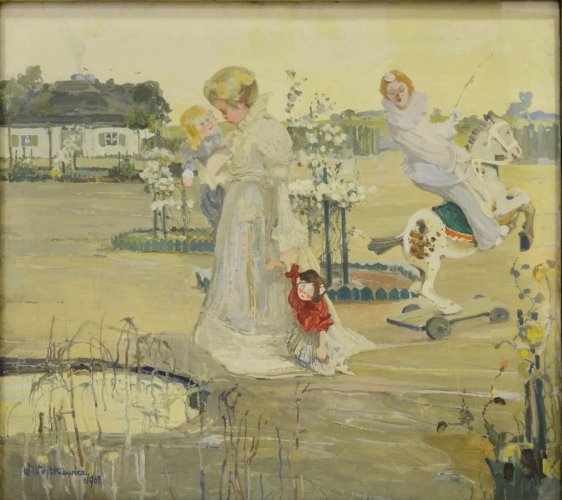Description:
Witold Wojtkiewicz (1879-1909) came from a large middle-class family. In 1903 he began his studies at the Krakow Academy of Fine Arts, attending Leon Wyczółkowski’s studio. He was active as a painter, draftsman and graphic artist. He was a co-founder of the “Zielony Balonik” cabaret and the artistic “Group of Five”, which included Vlastimil Hofman. He exhibited his works from 1902. He also appeared at the Paris Autumn Salon. In 1908 he presented a series of six temperas at the Krakow TPSP, entitled “From Childhood Postures”, painted a year before the artist’s death: “Parting”, “Escape”, “Attack”, “Procession”, “Into the Abyss”, “Tournament”. The works were quickly purchased. Edward Aleksander Raczyński bought two paintings from this cycle – the first and the last *.
Description of the painting:
In “Parting” Wojtkiewicz takes the viewer to the suburbs of Krakow. On a courtyard decorated with flowering trees, two figures were shown – a girl and a clown. The child is dressed in a long white dress. On her head she has a wreath. In her right hand she holds her doll-child, the left leads another doll. The girl is headed to the left, towards the painted, small pond, puddle. In the opposite direction, the rider of a wooden horse on wheels is going – a clown. He drives the horse with a stick held in his hand, but constantly watches the girl. The parting, which is the subject of the painting, is accentuated by the posture taken by the child and the sadness of parting on the girl’s face, intensified by the clearly accentuated divergent directions in which the characters on the painting are heading. The second title of the work “Konik Zwierzyniecki” specifies the time presented on the painting and seems to explain the dress worn by the girl. It refers to the folk celebration that took place after the Corpus Christi procession. The inhabitants of the Krakow suburbs, dressed festively, went to Zwierzyniecka Street, where a scene dating back to the 13th century was played out of driving away the Tatars by the Zwierzyniec flotilla brotherhood **. In Wojtkiewicz’s view, the well-known Lajkonik in colorful clothes was replaced by the figure of a clown riding a child’s toy.
Wojtkiewicz created difficult paintings, on the border of waking and dreaming, reality and fantasy. At first glance, the seemingly real spaces of courtyards and gardens were populated only by the figures of children and the animated toys accompanying them. “I see masses of children playing like nowhere else in the world, […] tired of life at the age of 10, 12 […] A lot of puppet theaters, flowery flower beds, funny mothers, children posing directly for my painting […] small theaters with their glitter, cheap pathos and poetry, blurry, as if seen through the mist; sad, grotesque palaces, misshapen balloons, mirrors, dolls, colorful balloons, and lanterns, scenes with strange clowns and dancing marionettes […] all increase the unique atmosphere.”***.
In this way, he realized his vision of the “end of the century” art, in which serious existential issues and reflections were presented in the costume of comic, seemingly immature characters. The children in his paintings are deprived of childish joy and carelessness. The painter loads them with tasks and experiences that are not adequate to the knowledge and experience they possess. “Sad, dressed in heavy, wonderful costumes of fairy-tale courts, gnawed by passions that they cannot bear, they play in their immature way a genuine drama of love, jealousy, hatred and death.”****. The seemingly trivializing form gives the addressed topics an even more moving, because protesting, context.


